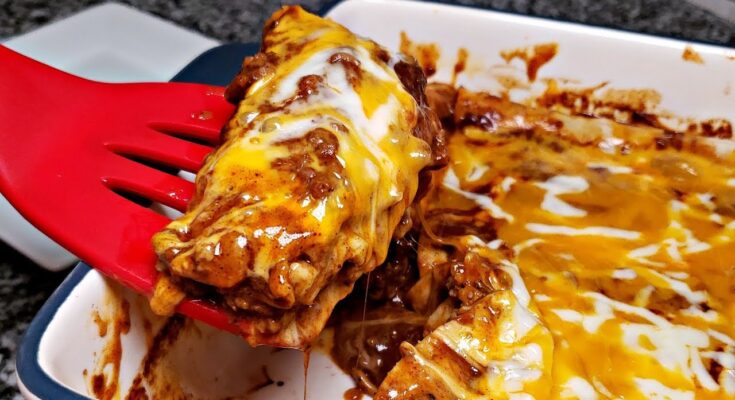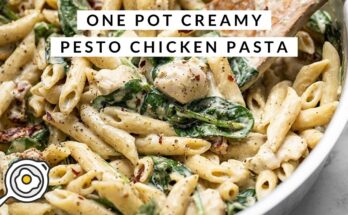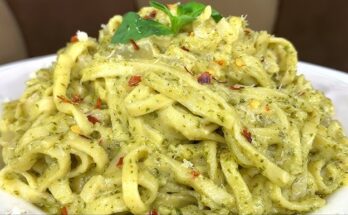Red Enchilada Sauce Recipe: Red enchilada sauce is the rich, zesty heart of many beloved Mexican dishes. It’s a smooth, slightly thick sauce typically made from a blend of chili powder, tomato paste, garlic, cumin, and broth. Its deep red hue comes from ground chilies or chili powder, giving it a smoky, savory flavor that’s absolutely irresistible. While you’ll often find it in cans at grocery stores, homemade enchilada sauce delivers a fresher taste, fewer preservatives, and more control over heat and seasoning.
Whether you’re building layers of flavor in enchiladas, spicing up burritos, or even jazzing up scrambled eggs, red enchilada sauce is that one bold companion every home cook should know how to whip up.
Why Make It at Home?
Store-bought sauce is convenient, sure—but it often lacks the punch and personality of a homemade version. By making it yourself, you’re not only ditching additives and excess sodium, but you’re also crafting a sauce tailored to your taste buds.
Want it smokier? Add chipotle powder. Like it tangier? Up the tomato paste. Prefer a milder kick? Use sweet paprika instead of hot chili powder. When you go homemade, you hold the flavor reins.
Beyond customization, making it at home is surprisingly easy and budget-friendly. A few basic spices, tomato paste, and broth come together in under 20 minutes to create a sauce that elevates every bite.
Ingredients Needed for Red Enchilada Sauce
Essential Spices and Pantry Staples
To craft the perfect red enchilada sauce, all you need are a few kitchen staples:
- Chili Powder – The star of the show, giving that signature deep color and earthy heat.
- Cumin – Adds warmth and complexity.
- Garlic Powder & Onion Powder – For depth and savory undertones.
- Oregano – Mexican oregano is ideal, but regular works too.
- Flour – Helps thicken the sauce into a luscious consistency.
- Tomato Paste – Adds tang and richness.
- Vegetable or Chicken Broth – Thins the sauce while infusing savory flavor.
- Salt and Pepper – To season to taste.
- Oil (vegetable or olive) – Used to make the roux.
These ingredients come together quickly, and once you’ve tried the homemade version, you’ll never want to go back to the canned stuff.
Fresh vs. Dried Chilies: Which One to Use?
Some traditional recipes use whole dried chilies like guajillo, ancho, or pasilla. These are soaked, blended, and strained for a robust, authentic flavor. While dried chilies bring unmatched depth, using chili powder is a fantastic shortcut without sacrificing much taste.
If you’re short on time or ingredients, chili powder is your best friend. But if you want to impress or explore authentic flavors, try using rehydrated dried chilies for a flavor-packed result.
Tools You’ll Need for the Recipe
Cooking Equipment Checklist
To make red enchilada sauce at home, you don’t need any fancy tools. Here’s what you’ll need:
- Medium saucepan – For cooking everything in one pot.
- Whisk – To ensure a smooth sauce without lumps.
- Measuring spoons and cups – Precision makes perfect.
- Blender or immersion blender (optional) – If using dried chilies or for extra-smooth texture.
- Strainer (optional) – If you like a silky, smooth sauce with no spice bits.
With these basic tools, you’ll breeze through the sauce-making process like a pro.
Step-by-Step Instructions to Make Red Enchilada Sauce
Step 1: Toasting the Spices
Start by heating your oil over medium heat in a saucepan. Add your flour, chili powder, cumin, garlic powder, and onion powder. Stir continuously for about 1–2 minutes. This forms a spice-infused roux that deepens the flavor dramatically.
Toasting the spices unlocks their oils, making your sauce more aromatic and flavorful. Don’t skip this—it’s what gives homemade enchilada sauce its character.
Step 2: Cooking the Roux
As you toast the spices in the oil and flour, you’ll notice a rich aroma rising. Stir steadily to prevent burning. The roux should take on a deep, reddish-brown hue. This base forms the thickening agent and flavor foundation of your sauce.
Keep your heat moderate and your whisk moving—you’re building flavor from the ground up.
Step 3: Adding Tomato Paste and Broth
Now, stir in the tomato paste and whisk until it’s well combined with your roux. Slowly add the broth while whisking to avoid lumps. You want a smooth, pourable consistency—something between a gravy and a tomato soup.
Bring the mixture to a simmer and let it cook for 10–15 minutes. Stir occasionally. The sauce will thicken as it cooks.
Step 4: Blending and Simmering
If you want a silky finish, you can use an immersion blender to blend the sauce right in the pot. This step is optional but adds a restaurant-style polish.
Taste and adjust salt, pepper, or spice level as needed. Once you’re happy with the flavor, remove it from the heat and let it cool before using or storing.
Customizing Your Sauce
Adjusting the Heat Level
One of the best parts of making red enchilada sauce at home is that you get to decide how hot—or not—you want it. Prefer a milder sauce that won’t scorch your tongue? Use a mild chili powder or swap in smoked paprika. Want something that’ll wake up your senses? Toss in a pinch of cayenne or chipotle powder. You can also mix and match dried chilies like ancho (mild) and arbol (hot) if you’re making the sauce from scratch with whole chilies.
Heat tolerance varies from person to person, so don’t be afraid to start small and work your way up. Remember: you can always add more spice, but you can’t take it out once it’s in!
Adding Extra Flavors
Think of red enchilada sauce as your flavor canvas. Want more smokiness? Add a roasted red pepper or a bit of smoked paprika. Craving a touch of sweetness? A dash of cinnamon or even a spoonful of honey can balance the heat and acid.
Other great additions include:
- A splash of vinegar or lime juice for brightness
- A pinch of cocoa powder for a mole-style twist
- Roasted garlic or caramelized onion for depth
Tweak it till it tastes like your ideal version of comfort food.
Tips for the Best Homemade Red Enchilada Sauce
If you want your enchilada sauce to taste like it came from your abuelita’s kitchen, these tips can help:
- Use high-quality spices. Cheap chili powder can taste flat or bitter. If you can, go for brands known for freshness and flavor.
- Don’t rush the roux. Toasting the flour and spices is where all the flavor begins. Give it time to develop.
- Simmer, don’t boil. Letting the sauce gently simmer allows the flavors to meld without over-reducing or burning.
- Taste as you go. Adjust salt, spice, and acid as you build the sauce. Your taste buds are your best tool.
- Blend for texture. If you prefer a silky smooth sauce, blending is worth the extra step.
Remember: making enchilada sauce isn’t about perfection—it’s about pouring love into your food.
Common Mistakes to Avoid
Even a simple recipe can go off the rails if you’re not careful. Watch out for these common slip-ups:
- Burning the roux: If the flour and spices cook too long or at too high a heat, they’ll taste bitter. Keep the heat moderate and stir constantly.
- Skipping the simmer: Some folks rush through the final step and miss out on flavor. Simmering helps everything meld beautifully.
- Over-salting: Broths vary in salt content. Taste before adding extra salt.
- Using the wrong chili powder: Not all chili powders are the same. Avoid chili seasoning blends (which often contain salt and other herbs). Go for pure chili powder or combine your own dried chilies.
- Making too much (or too little): Know how much you’ll need. The sauce keeps well, but it’s best fresh.
Being mindful of these points ensures a smooth cooking experience with mouthwatering results.
Storage and Shelf Life
Refrigeration Tips
Homemade enchilada sauce can be made ahead and stored for convenience. Once your sauce has cooled to room temperature, transfer it into a clean jar or airtight container. It’ll keep well in the fridge for up to 5 to 7 days.
To reheat, simply pour it into a saucepan over low heat, stirring until warmed through. If it thickens too much, just add a splash of water or broth to loosen it.
Freezing for Long-Term Use
Want to stock up? Enchilada sauce freezes beautifully. Pour cooled sauce into freezer-safe containers or zip-top bags (lay them flat for easy stacking), then label and date them. Frozen sauce will stay good for up to 3 months.
When you’re ready to use it, thaw it in the fridge overnight or gently reheat it from frozen in a saucepan. Give it a stir and enjoy!
How to Use Red Enchilada Sauce
Classic Dishes You Can Make
Of course, red enchilada sauce’s first job is in enchiladas—corn tortillas filled with cheese, meat, or beans, smothered in sauce and baked to bubbling perfection. But that’s just the beginning.
Try it in:
- Chilaquiles – Toss tortilla chips in warm sauce and top with a fried egg
- Enchilada casseroles – Layer tortillas, sauce, and filling like a Mexican lasagna
- Burritos or chimichangas – Smothered with sauce for extra flavor
Creative Ways to Use Leftover Sauce
Leftover sauce? Don’t let it go to waste. Use it as:
- A spicy pizza sauce base
- A dipping sauce for quesadillas or taquitos
- A simmer sauce for shredded chicken or tofu
- A marinade for grilled vegetables
Once you’ve got a jar of this sauce in your fridge, you’ll start finding excuses to use it everywhere.
FAQs about Red Enchilada Sauce Recipe
1. Can I make red enchilada sauce ahead of time?
Yes! Red enchilada sauce can be made in advance and stored in an airtight container in the fridge for up to 5 days. You can also freeze it for up to 3 months.
2. Is red enchilada sauce spicy?
It depends on the recipe and the type of chili powder used. You can control the heat by adjusting the amount of chili powder or using a mild version.
3. Can I use tomato sauce instead of tomato paste?
Yes, but tomato paste gives the sauce a richer flavor and thicker consistency. If using tomato sauce, you may need to simmer longer to reduce the liquid.
4. Is red enchilada sauce gluten-free?
If you use gluten-free flour or cornstarch as a thickener, then yes—it can be made completely gluten-free.
5. What dishes can I use red enchilada sauce with?
Besides enchiladas, it’s great for burritos, tacos, tamale pies, Mexican lasagna, or as a dip for quesadillas.
Conclusion
Red enchilada sauce is more than just a condiment—it’s a flavor foundation that turns any Mexican dish into something special. With a handful of ingredients and a few simple steps, you can create a bold, homemade sauce that puts canned versions to shame. Whether you’re making a weeknight dinner or a weekend feast, this rich and vibrant sauce will become your go-to for adding zest and warmth to every bite.
So roll up those sleeves, grab your whisk, and get ready to spice things up in your kitchen. Your enchiladas—and your taste buds—will thank you.



